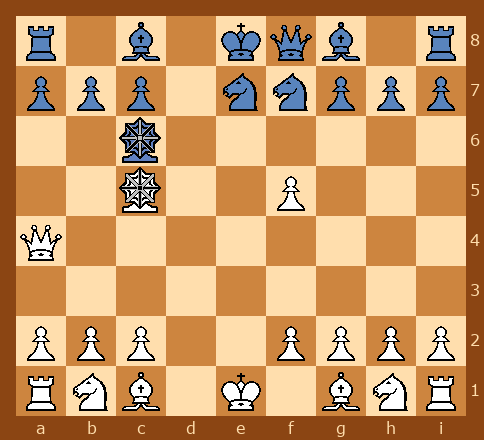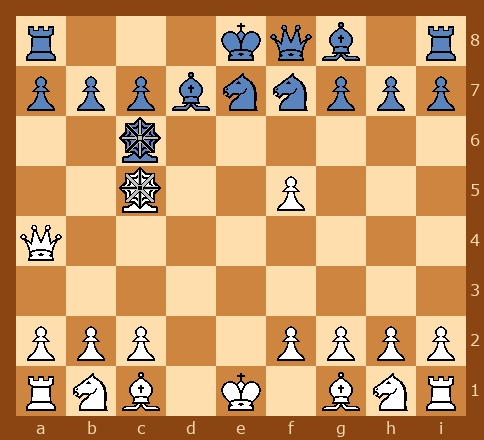Comments/Ratings for a Single Item
'9x9 Blockbusters'. Who know what it is? Put a 'CV' (chess variate) on 9x9, and most of the time it turns out very good or excellent. The only other category that holds for seems to be handful of particular human inventors -- to be named later. Who characteristically has > 10 CVs and > 50% Excellent? Only few, and we shall go out on our proverbial limb as usual, find them, and name them. Part of the reason for 9x9-types' inherent excellence has to be that Shogi amalgums -- chiefly standard Shogi -- on 9x9 are so poorly conceived. Certainly representing excellent culturally, Shogi nevertheless has been found mostly bad for play to most clubbers, worse than also-slow-paced Shatranj. Casual players in the western world find Shogi pieces, moreover, arbitrary and drops distracting. (At least Shatranj had coherence for its time.) Anyway, here is another fine, because original, '9x9', Sissa, recreating as it does ten years ago multi-path Sissa, after Coherent months earlier, and explaining it well enough in this article. The era was short-lived, 1995 - 2003 (when Ralph Betza left) that gave CVs spontaneneous inventiveness, with none of today's ego-driven ''new'' (and not so new (and not new at all)) combinations of elements and, worse, rating of others' CVs not very analytically, instead even with self-described vengeance aforethought. In other words, the modern ethos within CVPage includes that if someone criticizes one's CV, it is taken personally and calls for ''balancing the equation'' by rating the evaluaters' CVs or articles low, regardless of actual merit. Most of newer prolificists adhere to their such principle of ''vengeance rating.'' What a downturn from days of Ralph Betza's mixture of dry wit and informed judgment.
 H. G. Muller wrote on Sat, Sep 20, 2008 08:49 PM UTC:
H. G. Muller wrote on Sat, Sep 20, 2008 08:49 PM UTC:I don't see multi-path as an alternative to leaper / slide / hopper. Multi-path sliders aso exist, such as the Crooked Bishop. I aways thought 'lame' was a pretty accurate description for pieces that do not leap well. The name for any handicap is bound to be derogatory, as no one like to be handicapped. But being subject to blocking is definitely not a positive trait, the piece vaue suffers greatly by this. The Mao is worth only half a Knight. We could also call lame leapers 'creepers', referring to a mode of locomotion in tight contact with the ground, and thus easily obstructed. Multi-path is basically a fractional form of lameness, where multiple quares have to be occupied to block a move, while multiple lameness occurs when occupancy of one square can block several moves. (Such as in the Mao, which could be called doubly lame.)
Sissa is twenty years old this month. Sissa reaches by two different pathways each Rook square and each Nightrider square. The slides are its own, unlike those of regular R and regular NN.
Kevin is pointing out currently that Gabriel Maura's Modern Chess allows the Bishops both to stay on same color binding. Sissa here also 9x9 requires one Bishop only per color and the other opposite after each has moved. Still a third way to keep symmetrical starting placement, 81 spaces again, and unique handling of paired Bishops is found in George Dekle's Chesquerque. There the Bishops always have wazir-step conversion option as a turn. So, Chesquerque Bishops late in the game can "re-double up" on the same half ( +/- 0.5 ) of the squares -- powerful tool.
Jim Aiken's Double Diamond ( 9x9, 72 squares ) has same anytime one orthogonal.
Another and earlier one Chancellor Chess (9x9) settled on unsymmetrical initial array, so Bishops alway on their own 40/41 "half." Likewise Gilman goes for off-center positioned Bishops for full square coverage in things like Bachelor Kamil ( 9x9 ).
@ Carlos
In our game log below, the preset is not letting me make the apparently legal move 9...Nf7-d6:
https://www.chessvariants.com/play/pbm/play.php?game=Sissa+Chess&log=sissa-panther-2023-272-622
Could you please specify what the software "says"? Since the preset was edited using HG Muller's Play-Test Applet, we're going to need him to help us. I hope he finds out about this message.
Hi Carlos. Note that I tried to mouse-move my knight:
The error message says:
SYNTAX ERROR IN USER INPUT n f7-d6 on turn 9:
compose_move: #to is not a valid coordinate
Go back and try again.
Thank you Kevin. Playing the game using the "PLAY someone at the same location" resource, I actually find said message. I don't know if the bug is related to the fact that the following alert appears at the top of the page:
Your FEN Code has fewer ranks than are indicated in Rank Labels.
EDIT: I just corrected the discrepancy in the Rank Labels so the alert has disappeared but the bug remains.
@HG:
Could you please take a look at the problem before mentioned in this comment thread? Thanks in advance!
 H. G. Muller wrote on Sun, Oct 1, 2023 07:35 AM UTC in reply to Carlos Cetina from 04:51 AM:
H. G. Muller wrote on Sun, Oct 1, 2023 07:35 AM UTC in reply to Carlos Cetina from 04:51 AM:@Fergus: Although this preset is automated with GAME code generated by the Play-Test Applet and the betza.txt include file, I don't think that is the problem here. This error message is not anywhere in that code, and I also do not have or refer to any routine compose_move. There is a routine in betza.txt that uses #to as a local variable, but it doesn't try to create a move out of that before passing its value to other routines, under another name.
The error message sounds a bit like Game Courier is already rejecting the move before it would pass it to any user-supplied GAME code for vetting. Do you recognize it as anything that Game Courier could print?
I could not try anything out myself; if I follow the link to the preset page, it doesn't allow me to enter any move; if I click the highlighted destination square it just reverts to the (unhighlighted) original position. Probably because I am not one of the players.
I could not try anything out myself; if I follow the link to the preset page, it doesn't allow me to enter any move; if I click the highlighted destination square it just reverts to the (unhighlighted) original position. Probably because I am not one of the players.
Thanks for answering, HG. I was waiting for an answer from Fergus to your question. Apparently he didn't see it. What you are referring to is somewhat strange, since anyone who accesses the Sissa Chess preset must be able to reach the critical position in which the bug arises using the "MOVE pieces by yourself" resource, carrying out the following movements:
1. P e2-e4 P e7-e5
2. P d2-d4 P e5-d4
3. Q d1-d4 N b8-c6
4. Q d4-a4 P f7-f5
5. P e4-f5 P d7-d5
6. Q a4-i4 N h8-f7
7. S f1-d5 N c6-e7
8. Q i4-a4 S d8-c6
9. S d5-c5

Checking all the possible legal moves of the Blue side one by one, I found that the software rejects all but two: 9... B c8-d7 and 9... P b7-b5.


Curiously, both moves fall on the a4-e8 diagonal, with which the mystery of what causes the bug becomes more acute.
Does this give you any clues about what's going on?
 H. G. Muller wrote on Tue, Oct 3, 2023 12:04 PM UTC:
H. G. Muller wrote on Tue, Oct 3, 2023 12:04 PM UTC:OK, that helps. And I found a much shorter game that evokes the same error:
1. e4 d5
2. Sxd5 Nb6
3. Sc5
Then 3. e5 crashes the preset. There is some unexpected behavior here, in that setting 'to' to a nonexisting element of an array sets it to #to, instead of an invalid value, like it makes the variable disappear altogether. But I should be able to solve this now.
The error message says:
SYNTAX ERROR IN USER INPUT n f7-d6 on turn 9:
compose_move: #to is not a valid coordinate
When a variable has not been assigned a value, it is sometimes treated as a string literal of the named variable. So, what we have here is the variable named to without any value assigned to it. See where #to appears in the code, and make sure it has been assigned a value, and that that value is a valid coordinate.
 H. G. Muller wrote on Tue, Oct 3, 2023 04:42 PM UTC in reply to Fergus Duniho from 03:06 PM:
H. G. Muller wrote on Tue, Oct 3, 2023 04:42 PM UTC in reply to Fergus Duniho from 03:06 PM:Indeed, this is exactly what happened. I had a statement
set to elem #k #tosqrs;
and through a bug elsewhere k had gotten the value -1. So this must have set to to the string value "#to". This was passed through many other variables, finally ending up as the destination operand in a move command. This apparently calls compose_move internally, which produced the error message.
Ultimately I could trace the source of the error to the variable that held the range of the leg of a move not being declared as local in a my statement, so that the recursive call that happens for two-leg moves (such as those of the Sissa) spoiled it for the earlier instance. Turned out I had declared the variable in the my statement as 'range', while the code in the routine consistently used 'rng' instead.
I think it should work now that I changed the declaration to rng. In my test position it no longer complains.
The bug has been fixed. Thank you very much HG and Fergus.
Symmetric Sissa is a nice compliment to this original CV with the use of Sissas.
I think this piece caled Sissa is great, but I would remove acute angles (45 and 315 degrees) and only keep obtuse angles (135 and 225 degrees).
I would also remove the rule that both moves have to be of the same length. This will create a new piece that can make an absolute mess on the chessboard.
22 comments displayed
Permalink to the exact comments currently displayed.